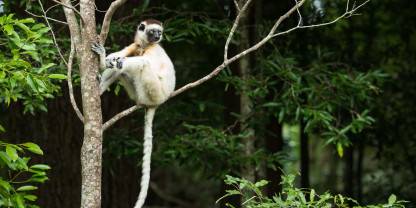Community-managed Ifotaka Forest is a great place to observe and photograph some key lemur species. The habituated ring-tailed lemur is very common in patches of gallery forest, while Verreaux’s sifaka is pretty much guaranteed in the . Night walks offer a chance to see lemurs and chameleons that are not active during the day. The birdlife is very rewarding, particularly in the spiny forest.
Wildlife Highlights
Watching Verreaux’s sifakas leap dramatically between octopus trees is a real highlight. Even more memorable is the peculiar sideways ‘dance’ performed by these acrobatic lemurs when they cross a patch of open ground. Night walks in the offer a chance to see three nocturnal lemur species. These are white-footed sportive lemur, grey mouse lemur and grey-brown mouse lemur. Nighttime is also good for seeing chameleons, such as the warty chameleon, which show up white when lit up with a spotlight.
Best Time for Wildlife Viewing
Wildlife viewing is good throughout the year, but the best time to visit is during the drier months from April to November. Mandrare River Camp is closed during part of the Wet season: the three months over January to late March. December tends to be wet and humid and some visitors might find the conditions oppressive. The lemurs are around at any time, but reptiles and some mammals are less active during the coldest months from June to August. April is a special time to see ring-tailed lemurs ‘stink-fighting’ (competing for mates by rubbing their tails on their scent glands and then wafting their smelly tails at each other).



 View Photos (10)
View Photos (10)
 +10
Photos
+10
Photos